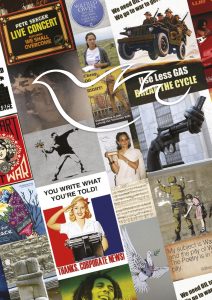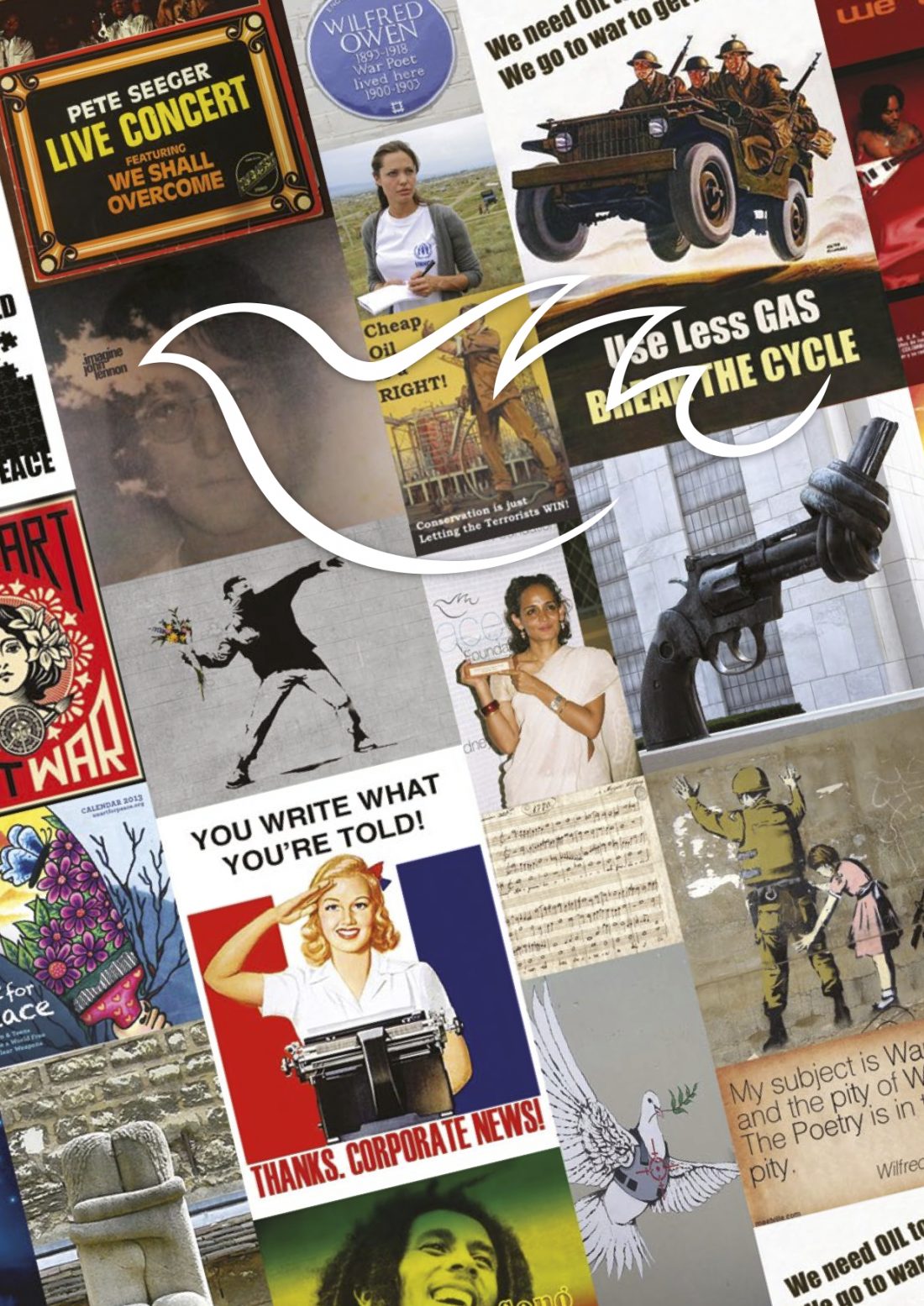Exploring “The Art of Peace” and the 2015 Sydney Peace Prize
What do The Beatles, Bono, Bob Geldof, Billy Bragg, Billie Holiday, Ben Harper, Bob Marley, Bob Dylan, and Barenboim all have in common—in addition to being musicians and starting with “B”? They have each contributed to peace with justice, and those who are still alive are suitable nominations for the 2015 Sydney Peace Prize.
The theme for the 2015 Sydney Peace Prize is “The Art of Peace”, which plays on Sun Tzu’s ancient Chinese military treatise “The Art of War” that has been a manual for war makers for centuries.
This theme calls for reflection on the experience of peace with oneself, with other people, with other countries, and with our planet; and on the role of the creative arts in that pursuit. This article explores some fundamental questions surrounding the theme “The Art of Peace”: what is art, what is peace, how are art and peace related, and how will the Jury make their selection?
From paintings in caves to sculptures of feminine figures, pottery, religious monuments, architecture and paintings, art has been pivotal to the development of human consciousness, communication, culture and society. Across the world’s cultures, art is found in expressions of dance, music, fashion and literature. It is found in photography, film, blogs and video games.
The act of creating art can reflect and stir feelings of wild conflict inside artists and in their audiences. Art holds a mirror at society, and in its reflection we don’t always like what we see. Art can surface deep emotions; it can delve into the depths of what it means to be human.
Art has the power to encourage critical thinking, awareness, foster empathy, amplify voices, create visions, dialogue, build relationships, empower and inspire its audiences to work toward peace with justice (Harlap 2006: 223).
Whether art contributes to war or peace depends on how it is used. Art can and has been used as tool of propaganda and oppression. Art can and has been a tool of protest and freedom. With this theme the Sydney Peace Foundation seeks to highlight the work of artists who have contributed to global peace.
Peace is often imagined to be the absence of war. According to such a definition, a peaceful society can also be an oppressive society. A society’s laws and culture may limit the freedom of people of a specific gender, sexual preference, culture or economic standing.
To distinguish an oppressive peace from a more desirable vision of peace, we turn to consider peace with justice. This more holistic vision of peace strives for the absence of violence in all its forms. As the Founder of the Sydney Peace Foundation, Stuart Rees (2003: 20) writes:
“A just peace would be marked not only by and end to hostilities between peoples but also by fairness in social, economic and political arrangements. It would be a fairness characterised by equality of opportunity and by associated influences in the building of civil societies.”
A vision of peace with justice seeks to address discrimination against people because of their culture, gender or religion, the huge and widening gap between rich and poor, and the uncalculated use of limited planetary resources. It works toward a world in which all people have the opportunity to go to school, access health care, receive a fair wage for their work. It imagines a world where conflict is resolved through non-violent mechanisms, where the Universal Declaration of Human Rights is observed and experienced by all of humanity, and animals are treated with similar respect. It envisages a world where a diversity of ideas, cultures and species are valued, and where the principles of The Earth Charter are enacted in practice.
Many-a lifetimes have embodied this art, as seen in the work of the sixteen Sydney Peace Prize recipients including Noam Chomsky, Desmond Tutu, Mohammed Yunus, Mary Robinson, Arundhati Roy, and this year Julian Burnside. The art of peace is exemplified in the care and actions of these people.
As for the 2015 Sydney Peace Prize, the Foundation is seeking nominations of people whose lives not only illustrate the art of peace but, more specifically, we seek nominations of people who themselves are artists.
Over the centuries, painters, poets, musicians and performers have stood up as icons and influencers for anti-war and social justice movements across the world. Artists have worked to raise awareness and understanding of issues of inequality, oppression, bullying and discrimination.
Consider the impact of songs such as Pete Seeger’s “We Shall Overcome” and the socialist anthem “The Internationale”, Sibelius’ Finlandia’s “Song of Peace”, Michael Jackson’s “Heal the World”, Lenny Kravitz “We Want Peace”, Louis Armstong’s “What a Wonderful World”, John Lennon’s “Imagine”… the list goes on.
Sometimes directly and intentionally, and sometimes in an indirect cultural impact or unintentional, and sometimes unknown, artists can inspire large-scale contributions to peace with justice. The documentary “Sugar Man” tells the story of Sixto Rodriguez, whose music (unknown to him) provided the soundtrack to the anti-apartheid movements in South Africa.
Wilfred Owen’s Anthem for Doomed Youth and Dulce Et Decorum Est paint depressing pictures of the butchery of the First World War, that have lasted for now a century. As part of school curriculums, children are stung with the image of ‘What passing-bells for these who die as cattle?’ and ‘The shrill, demented choirs of wailing shells’.
Sam Hamill’s website Poets Against the War shares tens of thousands of poems protesting the Iraq war in 2003. In Great People Distracted Stafford (1996: 25) writes of those who ‘try to impose their whole universe’ and responds ‘I can’t eat that bread’.
Paintings like Picasso’s “Dove of Peace”, “Let Us Have Peace” by Jean Leon Gerome Ferris, to satirical comics and graphic artists such as Micah Ian Wright make poignant points about the irony of dominant narratives and the need for peace. Sculptures and monuments such as “Non-Violence” (The Knotted Gun) by Carl Fredrik Reuterswärd, remind us of alternatives to war.
Comedians such as George Carlin and Russell Brand, point to the problems in capitalism, dogmatism and in an absence of critical reflection and social justice.
Films such as Casablanca, The Help, The Lady, The Killing Fields, Avatar, and Cloud Atlas, Philadelphia, City of God, draw attention to the costs and horrors of war, the effects of colonization in Indigenous peoples, and the importance of striving for more harmonious relationships with neighbouring countries and within our own.
Angelina Jolie, Jude Law, Sophia Lauren, George Clooney, Jeremy Gilley and many others have used their profiles to advance the cause.
The work of Leo Tolstoy, Claudio Magris, Antonio Lobo Antunes, Liao Yiwu, Khaled Hosseini, Harper Lee, Paulo Coelho… the list goes on and on…. So many authors, song-writers, musicians, performers, actors, come to mind!
The Foundation is seeking nominations of individual artists or art-related organisations that demonstrate:
- Significant contributions to the achievement of peace with justice, for example steps to eradicate poverty, racial or sexual discrimination, or environmental destruction;
- A commitment to the promotion and attainment of human rights; and
- An illustration of the philosophy, language and practice of nonviolence.
The contribution may have been made through their art, or outside it. These three criteria guide the Jury’s selection process—deliberations that take place over a three-month period. The Jury is selected by the Sydney Peace Foundation Council, and is confidential after the selection process is complete.
In order to receive the Sydney Peace Prize—$50,000 plus a handcrafted trophy by Australian glass artist Brian Hirst—the nominee must be able to travel to Sydney in the second week of November 2015 to present the City of Sydney Peace Prize Lecture at Town Hall, where he or she will be awarded the Prize.
Through the awarding of this prize for peace, the people of Sydney have an opportunity to learn directly from the world’s most inspiring peacemakers. Through the international media coverage the Prize initiates and via a broadcast of the speech across the Internet, people across the world can be inspired to contribute to the evolution of a more peaceful, just and sustainable global society.
Won’t you help to sing, These songs of freedom? (Bob Marley, Redemption Song)
Submit a nomination:
In order to be considered for the Prize, a person must be nominated. To make a nomination, submit a paragraph or two describing the ways that your nominee has contributed to peace with justice, with respect to human rights and non-violence, and how the nominee might further contribute to peace with justice if they are selected to receive the prize.
Download a 2015 SPP Nomination Form (PDF) to assist with the process, and email your submission to:
Post submissions to:
Sydney Peace Foundation
Mackie Building K01
University of Sydney NSW 2006.
Nominations are due by 31 August 2014.
View the call for nominations: https://sydneypeacefoundation.org.au/nominate/2015-the-art-of-peace-call-for-nominations/
For further details of the Jury process please visit: https://sydneypeacefoundation.org.au/nominate/
References:
Baraka, Amiri (1995). Transbluesency: Selected poems 1965-1995. New York: Marsilio Publishers.
Harlap, Yael. (2006). Toward training; The meanings and practices of social change work in the arts. Vancouver: Judith Marcuse Projects. http://www.ccl-cca.ca/pdfs/OtherReports/MarcuseSocialChangeInArtsEN.pdf Viewed 4 June 2014.
Rees, Stuart (2003). Passion for Peace: Exercising Peace Creatively. Sydney: UNSW Press.


